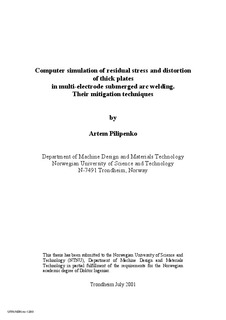| dc.contributor.author | Pilipenko, Artem | nb_NO |
| dc.date.accessioned | 2014-12-19T11:25:08Z | |
| dc.date.available | 2014-12-19T11:25:08Z | |
| dc.date.created | 2001-01-08 | nb_NO |
| dc.date.issued | 2001 | nb_NO |
| dc.identifier | 126204 | nb_NO |
| dc.identifier.isbn | 82-471-5340-8 | nb_NO |
| dc.identifier.uri | http://hdl.handle.net/11250/231322 | |
| dc.description.abstract | Welding is the main joining method used in shipbuilding. A multi-electrode submerged arc welding is usually applied to long joints of massive components since the early 1950s.
The problem of welding stresses and deformations arose almost simultaneously with the introduction of welding as a joining method. In 1892 Slavianov, in his works, mentioned about "harmful stresses in metal" appearing during welding. Despite tremendous development in welding technology since that time, this problem is still present.
This dissertation presents the development of an experimental, numerical and analytical approach to the analysis of weldability. Focus is placed on the investigation of transient and residual welding stresses and distortions in thick-walled ship hull structures. The investigation mostly relies on the finite element analysis. Some recommendations about mitigation techniques for reducing their negative influence on welded structure efficiency are given.
A number of simulation systems for the sequentially coupled thermo-mechanical analysis of welding process, taking into account the welding conditions during the butt welding of thick-walled steel panels, are developed. Two welding techniques are investigated. The three-electrode one-pass welding process and the one-electrode multipass process are compared in terms of the joint characteristics and transient stresses and deformations.
The accuracy of each finite element models is evaluated based on experimental results and the results of the analytical solution.
Several techniques allowing to reduce residual stresses and deformations are investigated. Both, obtained results and governing phenomena, are studied and explained based on physical principles.
The first part of the thesis is a significant part of the work. Its purpose is a deep analysis of the thermo-mechanics of welding allowing better understanding of the complicated phenomena. | nb_NO |
| dc.language | eng | nb_NO |
| dc.publisher | Fakultet for ingeniørvitenskap og teknologi | nb_NO |
| dc.relation.ispartofseries | Dr. ingeniøravhandling, 0809-103X; 2001:75 | nb_NO |
| dc.subject | | en_GB |
| dc.subject | Materialvetenskap | en_GB |
| dc.subject | TECHNOLOGY: Materials science | en_GB |
| dc.title | Computer Simulation of Residual Stress and Distortion of Thick Plates in Multielectrode Submerged Arc Welding: Their Mitigation Techniques | nb_NO |
| dc.type | Doctoral thesis | nb_NO |
| dc.source.pagenumber | 222 | nb_NO |
| dc.contributor.department | Norges teknisk-naturvitenskapelige universitet, Fakultet for ingeniørvitenskap og teknologi | nb_NO |
| dc.description.degree | dr.ing. | nb_NO |
| dc.description.degree | dr.ing. | en_GB |
